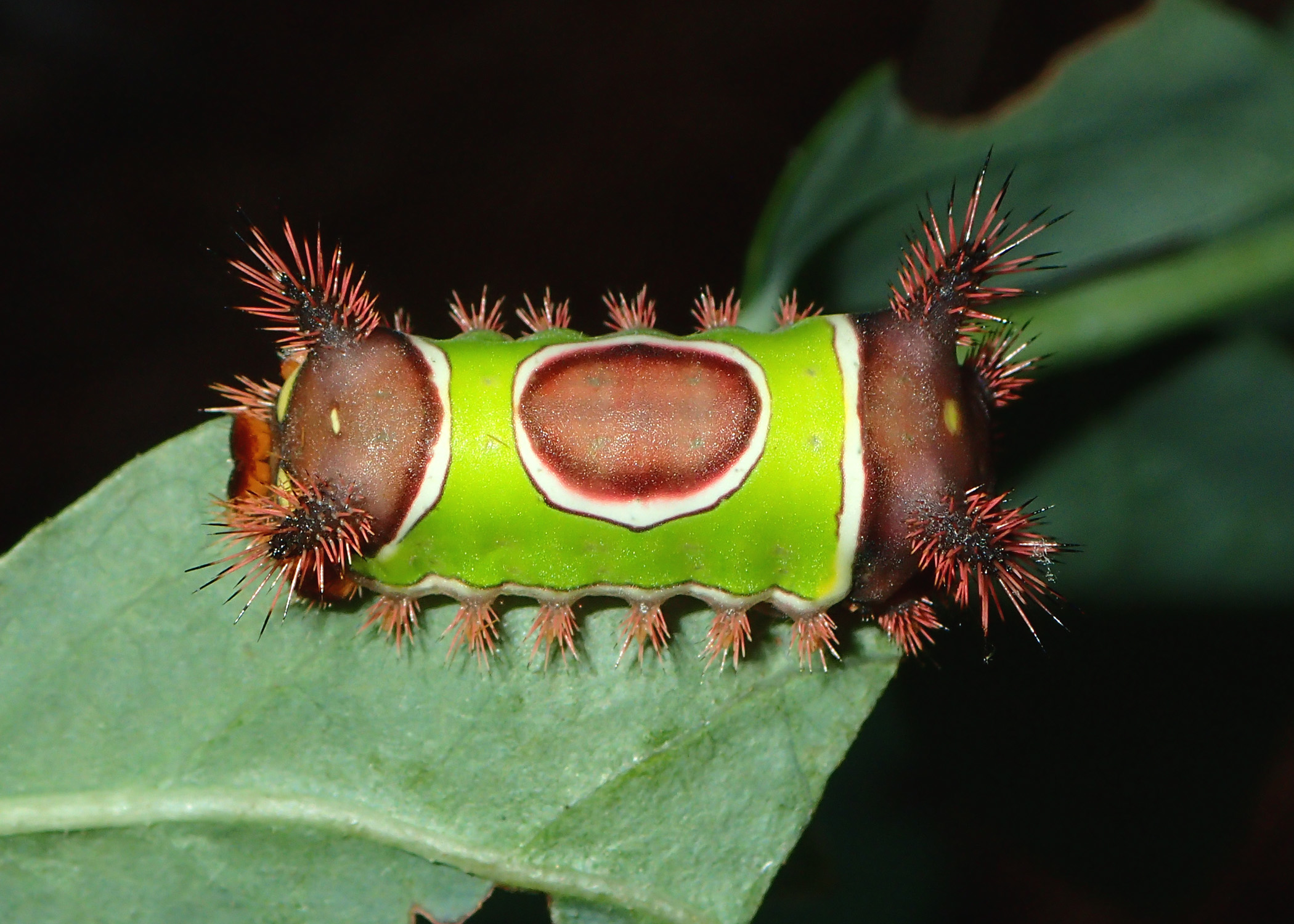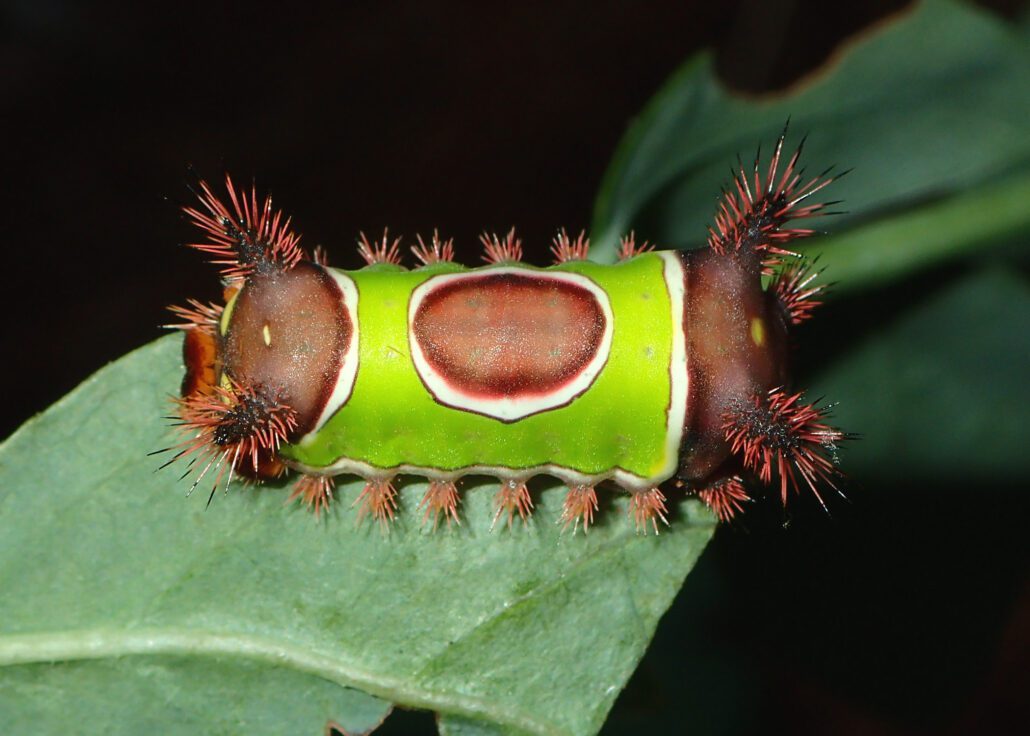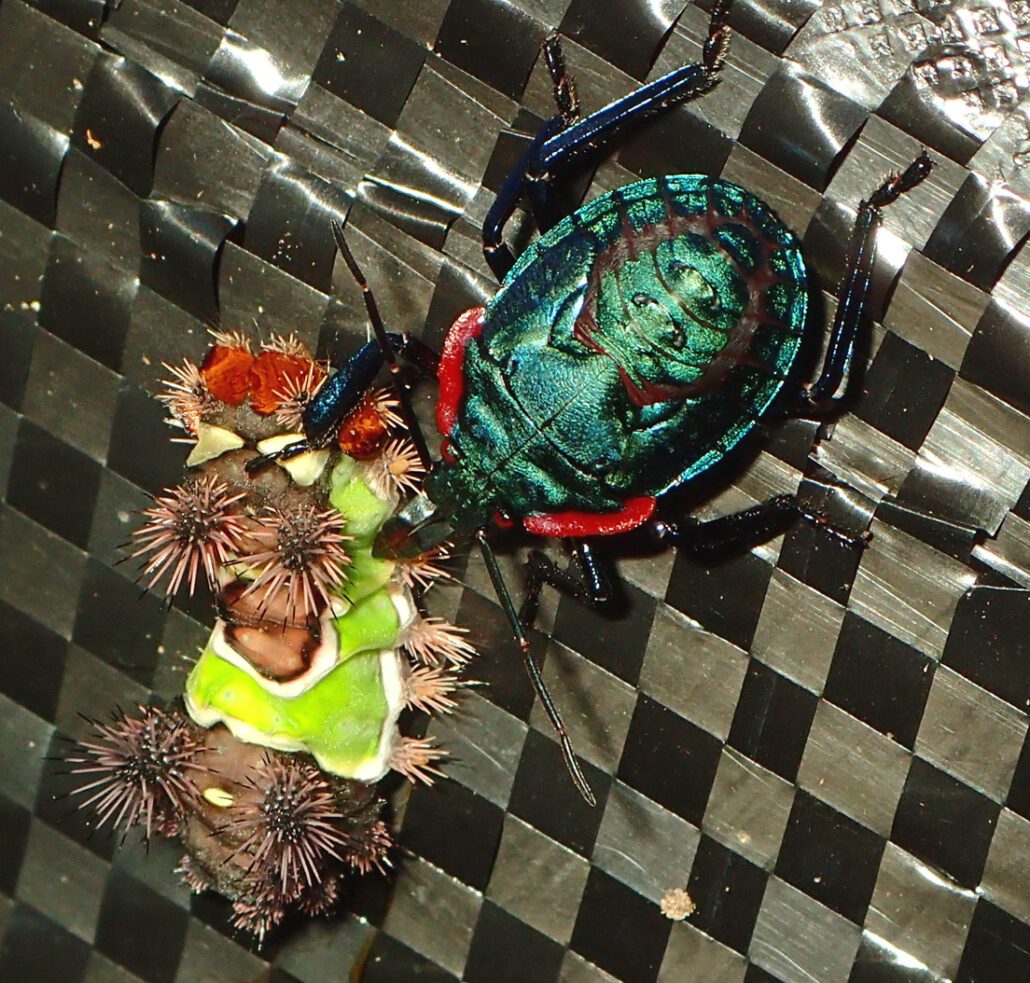
by Kate Redmond
Bug o’the Week Saddleback Caterpillar A Snowbird Special
Greetings, BugFans,
Today’s bug, the extraordinary-looking and aptly-named Saddle-backed caterpillar, is the 5th in our on-going Snowbird Special series about bugs you might see if you decide to tear yourself away from God’s Country in the winter. The BugLady doesn’t know why one might consider that – except she’s posting this before dark because there’s a massive storm that’s raining all over her, accompanied by 20-plus mph north winds, and is delivering many inches of snow inland. She suspects that the power will fail eventually.
Thanks to BugFan Tom in the Deep South for his pictures of this amazing caterpillar.
The Slug caterpillar family Limnacodidae has appeared in these pages before https://uwm.edu/field-station/bug-of-the-week/slug-moths-tale-two-parts/. Limnacodidae means “snail/slug-form” and refers to its caterpillars, some of which look like space aliens, while others are limpet-shaped. They have suckers instead of abdominal prolegs https://bugguide.net/node/view/225763/bgimage (prolegs are fleshy, unjointed “legs” that act as anchors, gripping the surface while the true legs (on the thorax) and the muscles in the body work to move it along). Slug caterpillars exude a lubricant (not slime, like snails and slugs, but a type of liquid silk) that allows them to contact the substrate more completely and to glide/undulate through life. Some have a smooth exterior, some are bristly, and some, like the Saddleback caterpillar, have fleshy horns decorated with hollow, stinging spines and hairs that will get your attention if you encounter one (more about that in a sec).
Slug moths tend to be dark, sturdy, and hairy, with wide wings. They can’t hear and they don’t feed, and they generally live for little longer than a week. They often perch with the tip of their abdomen raised, though other kinds of moths do that, too.
The BugLady always thinks of members of this family as belonging to the Deep South (because they have more “sting-y” things down there), but the range of the Saddle-backed caterpillar extends from Massachusetts to Florida to Texas (and points south) to Kansas, and through parts of Illinois (the BugLady saw a few maps that showed the species in far southern Wisconsin). A number of species of Limnacodids are native to Wisconsin, including:
the Spiny oak slug https://bugguide.net/node/view/2212985/bgimage,
the Crowned slug moth https://bugguide.net/node/view/1938355/bgimage,
and the less-fancy but still lovely Shagreened slug moth https://bugguide.net/node/view/1859138/bgimage, and Skiff moth https://bugguide.net/node/view/446465/bgimage.
Without further ado, the SADDLEBACK CATERPILLAR (Acharia stimulea).

Adults fly in June and July in the northern parts of their range and pretty much all year Down South. The eggs – so transparent that the tiny larvae may be seen inside https://bugguide.net/node/view/2003668/bgimage – are deposited at night in clumps of 30 to 50 on the undersides of the leaves of host plants.
It’s not hard to find a host plant, because Saddleback Caterpillars eat the leaves of a pretty wide variety of trees, shrubs, wildflowers, grasses, garden plants and horticultural plantings. Their only stipulation is that the leaves be smooth, not pubescent (hairy) – the rough texture of hairier leaves interferes with their ability to adhere and to move.
Like other species of slug moths, Saddle-back caterpillars are, initially, gregarious leaf skeletonizers, nibbling at the tender surface of the underside side of a leaf and eschewing the tough leaf veins https://bugguide.net/node/view/954559/bgimage. As they grow, they take on the whole leaf and eventually become more solitary. Caterpillars take four or five months to mature (here’s a pretty cool shot of one that just molted https://bugguide.net/node/view/1570339/bgimage).
About the sharp bits:
The long, hollow spines contain a “hemolytic and vesicating venom” (a red-blood-cell-destroying and blister-raising venom) and will break away from the caterpillar and embed in whatever bumped/grabbed them (removing the spines gently and immediately with tape is highly recommended, followed by an ice pack) (and maybe an adult beverage). Are the spines effective?
Wagner, in Caterpillars of Eastern North America, says that, due to its size and quantity of its stinging spines, “The sting of the Saddleback Caterpillar may be the most potent of any North American caterpillar.”
One contributor to bugguide.net wrote that “I grabbed a dead looking leaf off my small incubating Rose of Sharon in the evening. After that I don’t remember much. It was horrifying being stung by this well equipped little creature from another planet.”
A Virginia Extension Agent likened it to “getting hit by a jellyfish.”
The spines, which are part of the caterpillars’ redundant defense system, give pause to most vertebrate and invertebrate predators. The venom can trigger intense pain, hives, migraines, GI issues, asthma, and even anaphylactic shock. Yet they are vulnerable to tiny parasitic wasps that slip in between the spines and inject eggs into the caterpillar’s body. The wasp larvae consume the inside of the caterpillar and then crawl outside to pupate in cocoons that look like tiny swabs https://bugguide.net/node/view/79421/bgimage. And Tom photographed one in the clutches of the awesome nymph of a Giant Strong-nosed stink bug

They spend the winter as pre-pupae, and as they’re preparing to pupate, they intentionally expel fluids and frass from their bodies and shrink by about half. The result is that the spines are more “concentrated” on their body surface than before. They also release calcium oxalate (that’s the stuff that makes skunk cabbage poisonous), which forms crystals in the fabric of the cocoon and hardens it. Spines may also be woven into the silk of the cocoon, too, and scattered around it. Despite this, there’s still predation on the pupae.
The Bottom Line: The moth is stunning https://bugguide.net/node/view/752824/bgimage, (and almost no one is sensitive to its hairs). The caterpillars are cute as a button when they’re kittens https://bugguide.net/node/view/2225127/bgimage and are beautiful when they’re mature (about ¾” long). The striking pattern of older caterpillars is thought to be aposematic (warning) coloration. Plus, older caterpillars have a startle reaction that puts their spines at the ready. Plus, their adhesive abilities mean that if you do bump one, it won’t just drop to the ground, encounter over – it will stick to its spot. Plus, from the rear, their markings make a scary face https://bugguide.net/node/view/693213/bgimage. Take the hint (and maybe don’t go barefoot, and maybe don’t grab ahold of a leaf without checking its underside).
Special Treat – a Spun glass slug https://bugguide.net/node/view/2211409/bgimage (very young), and older https://bugguide.net/node/view/1480728/bgimage, https://bugguide.net/node/view/990165/bgimage, https://bugguide.net/node/view/9412/bgimage.
Special Thanks to the awesome folks at the University of Wisconsin Milwaukee who format the episodes and archive them on the Field Station website (and make them look good!).
Kate Redmond, The BugLady
Bug of the Week archives:
http://uwm.edu/field-station/category/bug-of-the-week/
